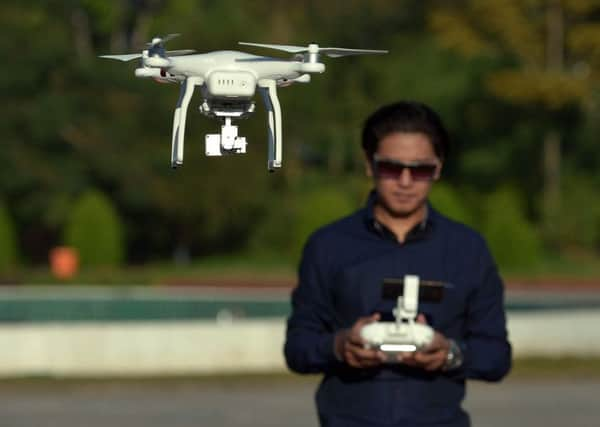Jane Bradley: Drones on the rise, but for how long?


When motor cars first hit Britain’s roads more than a century ago, no-one really knew just how popular they would become.
They were a novelty, something owned by a tiny minority.
Indeed, to drive one, you did not need a licence. You merely hopped behind the wheel and had a go.
Advertisement
Hide AdAdvertisement
Hide AdGranted, in the early days, there was a chap walking in front of the vehicle waving a flag, as you crept along at just a few miles an hour. You weren’t likely to do a lot of damage.
But, as they rose in popularity, the authorities began to get wise to the fact that there needed to be some regulation.
People who wanted to drive a car needed to be registered, they needed to have a licence. However, in the early days, that did not mean they needed to pass a test or show any level of skill.
No, it just meant that the early incarnation of the DVLA had a list of everyone crazy enough to want to travel in one of these death machines. Drivers only had to display registration marks on their vehicle and be licensed annually at a cost of 20 shillings – around £1.
I believe my grandad was one of these people. When he decided to drive a car, around the early 1940s, the driving test, brought in just a few years earlier, in 1945, had been suspended for the duration of the war. So he just nipped down to his local town and acquired himself a driving licence, which he used until his death in the late 1980s. My grandad, from what I remember, was a good driver. But there is no doubt that the introduction of a stringent test to make sure that people can drive safely and skilfully, is, inarguably, a good thing.
I mention this, because it feels like drones – which have been flying off the shelves in the festive shopping period (pardon the pun) – are this generation’s motor car.
If you are one of the thousands of people in Britain who woke up yesterday morning to find a small helicopter wrapped up underneath the tree, congratulations.
It is the toy of choice, the gadget of envy, the thing that was top of as many people’s Christmas lists this year as smartphones and iPads: the drone. Or quadcopter, as it’s sometimes called. They’re apparently slightly different, but I can’t quite figure out how.
Advertisement
Hide AdAdvertisement
Hide AdYou probably spent your Christmas Day crowded into your local park, battling for air space with other drone owners in your neighbourhood.
For most of us, they are nothing more than a frivolity, an expensive toy (prices range from £50 up to over £700), the thing of dreams for tech lovers and Boy’s Own fans alike.
On the commercial side, drones are being heralded as the solution to delivery problems as the popularity of home shopping grows.
Amazon is set to, some day soon, start delivering packages by drone Stateside, while other smaller retailers are also hoping to start drone delivery, if – and this is the big if – government regulations allow it. Called Prime Air, Amazon’s team of drones will be able to deliver packages up to 15 miles away from the firm’s warehouses.
Meanwhile, they are also used to take aerial photographs and videos, with many drones sold coming with built in camcorders and cameras.
Yes, at the moment, drones are a novelty, but the authorities are starting to wake up to the potential pitfalls.
In the US, the Federal Aviation Administration (FAA) last week introduced a rule that all consumer drones – ie ones not owned by the military, or private companies – have to be registered in a bid to keep track of them.
In France, in the wake of the terror attacks on the French capital last month, the use of drones – as well as fireworks – in Paris was prohibited to protect public safety, signalling security officials’s concerns that they could be used for nefarious activities.
Advertisement
Hide AdAdvertisement
Hide AdHere, there are rules about where and how you can fly. The Civil Aviation Authority’s regulations are strict and failure to keep to them could result in prosecution.
UK drone owners should not fly their pride and joy higher than 400ft while the vehicles should be kept well away from planes, helicopters, airports and airfields. There are also privacy concerns. Drones fitted with cameras must not be flown within 50 metres of people, vehicles, buildings or structures or over congested areas or large gatherings such as concerts and sports events.
At the moment, drone flying might seem to be a happy free for all, as unregulated motor cars were at the turn of the last century.
But this is not likely to last. On a completely selfish level, while they might be fun for a bit, risking prosecution to fly what is essentially a pricey remote-controlled plane, seems to be folly - and only more likely to happen as time goes on and drone traffic becomes increasingly heavy and a bigger headache to police.
So, drone fans, enjoy your Christmas gift while you can, I have a feeling that regulation-free drone flying might be a short-lived freedom.
Or you could just stick to an old-skool, normal-sized remote control aeroplane – or a kite. Like in the good old days.
It would be a lot easier.